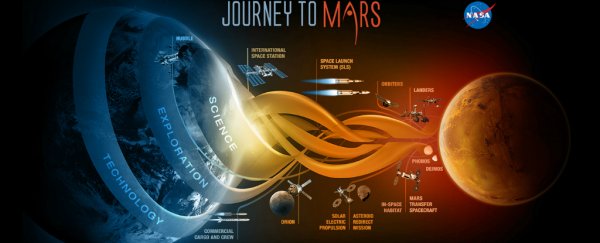Last year, NASA announced its three-step plan to land humans on Mars by the 2030s, and as you might expect, it was pretty ambitious. But now an annual report from the US Aerospace Safety Advisory Panel (ASAP) has cast doubt over whether the US space agency will actually be capable of pulling the mission off with an acceptable level of risk.
The main issues centre around NASA's limited budget, the amount of technology it needs to develop to get to Mars, as well as the tight deadline the space agency has set for itself. More broadly, the ASAP expressed concern over a lack of detail laid out in the agency's Journey to Mars report, released in October last year.
"Unfortunately, the level of detail in the report … does not really validate whether NASA would be capable of achieving such an ambitious objective in a reasonable time period, with realistically attainable technologies, and with budgetary requirements that are consistent with the current economic environment," the report explains.
So what is the ASAP? The panel was established in 1968, and its role is to make yearly safety recommendations to the NASA Administrator, Charles Bolden. This year, a large part of that involved looking into the Journey to Mars, which currently is made up of three key stages: Earth Reliant, Proving Ground, and Earth Independent.
The Earth Reliant phase involves a lot of longer missions on board the ISS, "and we're already well into it," we reported last year. The second stage involves NASA putting humans into deep space environments that will allow crews to return to Earth in a matter of days, such as the area around the Moon. And, finally, the Earth Independent stage will see humans reach the vicinity of Mars, including the planet's moons, and will involve missions that last two to three years.
"Although the document does identify a few specific technologies that will be needed to accomplish the overall mission, including Solar Electric Propulsion and a Deep Space Habitat, it lacks a top-level architecture and/or design reference missions," the report states. "Without these elements, it will be difficult to properly scope and sequence the needed technology development efforts to ensure that they will be available at the appropriate time."
The report also questions NASA's reluctance to lead further human missions to the Moon. "It is unclear how NASA will develop low-gravity surface experience and technology without lunar surface experience," the panel writes.
When asked to go into more detail, ASAP says NASA has replied that it's too early to set the plans in stone given today's limited technologies - the hope is that within the next two decades, improvements will be made that will radically change the way we build these types of systems. "They may also be concerned that spelling out a particular plan for reaching Mars today would somehow subject it to criticism by future administrations," says the report.
But the ASAP questions that logic. "The ASAP believes that a well-designed mission, with anticipated rewards that are expected to outweigh the risks, would go a long way toward gaining the needed support from future administrations, the Congress, and the general public," they conclude. "If not, then perhaps NASA should be working on a different mission, or at least using a different approach for the current mission … The NASA 'can-do' attitude, while commendable, must be guarded against so as not to compromise safety in this case."
